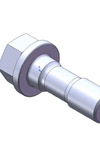Bespoke nuts
 There are a plethora of different kinds of nuts on the market, and many are aimed at the racing market. Most of these will have been designed originally for the aerospace sector, and here we benefit from the exceptional quality control that the aerospace industry demands. Despite this range of good quality proprietary parts being available to us, there are also a considerable number of racing engine manufacturers who have bespoke nuts manufactured to their own designs. These might be to fit into a particularly confined space, maybe to minimise the height of the nut, or perhaps to take advantage of the properties of a favoured material; the reasons for doing this are many, but it is almost certainly an expensive option, compared to using an available proprietary part.
There are a plethora of different kinds of nuts on the market, and many are aimed at the racing market. Most of these will have been designed originally for the aerospace sector, and here we benefit from the exceptional quality control that the aerospace industry demands. Despite this range of good quality proprietary parts being available to us, there are also a considerable number of racing engine manufacturers who have bespoke nuts manufactured to their own designs. These might be to fit into a particularly confined space, maybe to minimise the height of the nut, or perhaps to take advantage of the properties of a favoured material; the reasons for doing this are many, but it is almost certainly an expensive option, compared to using an available proprietary part.
There is an advantage to designing and using a bespoke nut which many do not take advantage of, and that is that the nut can be designed such that it can improve the fatigue life of the bolt or stud to which it is attached. Where there is a problem with a bolt of a stud which causes a fatigue failure at the face of the nut, this is because of the stress concentration at the first engaged thread. In many cases the engineer will look to strengthen the stud or bolt which is a sensible measure and by doing so he may increase the fatigue strength of the component quite markedly. However, it is possible to make an even greater improvement in the fatigue strength of the bolt by a number of simple changes to the design of the nut, and the material from which it is made.
It is a widely accepted fact that the distribution of load on the engaged threads of a bolt is far from uniform. In the recent Race Engine Technology Focus article on the subject of fasteners, the author wrote "When we come to calculate fatigue life, we see from literature that the load borne by the threads is not at all even. Zhukovski first proposed the now accepted hyperbolic load distribution as early as 1902. The effect is that, for a steel nut and bolt, with 10 engaged threads, 34% of the load is borne by the first thread, and 85% is carried on the first four threads alone." From Zhukovski's work, we can imagine that there is a significant stress raiser at the first engaged thread due to the concentration of stress. We can markedly reduce this stress concentration factor by changing the material of the nut, the design of the nut, or both. In terms of materials, it is possible to improve the uniformity of stress distribution by using a nut of a lower elastic modulus than the bolt or stud. If we are using a bolt made of steel or a superalloy, then the options for this are numerous. However for titanium bolts or studs, we have less choice because titanium has a comparatively low modulus. We should note that a steel nut on a titanium stud or nut is likely to have a worse distribution of load than the case examined by Zhukovski.
Fig. 1 - High quality proprietary nuts, aimed specifically at the racing and high-performance market (courtesy ARP).
Written by Wayne Ward